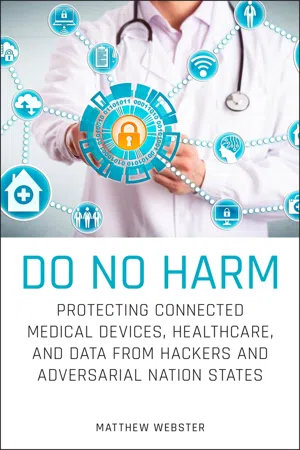
Do No Harm
Protecting Connected Medical Devices, Healthcare, and Data from Hackers and Adversarial Nation States
- English
- ePUB (mobile friendly)
- Available on iOS & Android
Do No Harm
Protecting Connected Medical Devices, Healthcare, and Data from Hackers and Adversarial Nation States
About this book
Discover the security risks that accompany the widespread adoption of new medical devices and how to mitigate them
In Do No Harm: Protecting Connected Medical Devices, Healthcare, and Data from Hackers and Adversarial Nation States, cybersecurity expert Matthew Webster delivers an insightful synthesis of the health benefits of the Internet of Medical Things (IoMT), the evolution of security risks that have accompanied the growth of those devices, and practical steps we can take to protect ourselves, our data, and our hospitals from harm.
You'll learn how the high barriers to entry for innovation in the field of healthcare are impeding necessary change and how innovation accessibility must be balanced against regulatory compliance and privacy to ensure safety.
In this important book, the author describes:
- The increasing expansion of medical devices and the dark side of the high demand for medical devices
- The medical device regulatory landscape and the dilemmas hospitals find themselves in with respect medical devices
- Practical steps that individuals and businesses can take to encourage the adoption of safe and helpful medical devices or mitigate the risk of having insecure medical devices
- How to help individuals determine the difference between protected health information and the information from health devices—and protecting your data
- How to protect your health information from cell phones and applications that may push the boundaries of personal privacy
- Why cybercriminals can act with relative impunity against hospitals and other organizations
Perfect for healthcare professionals, system administrators, and medical device researchers and developers, Do No Harm is an indispensable resource for anyone interested in the intersection of patient privacy, cybersecurity, and the world of Internet of Medical Things.
Frequently asked questions
- Essential is ideal for learners and professionals who enjoy exploring a wide range of subjects. Access the Essential Library with 800,000+ trusted titles and best-sellers across business, personal growth, and the humanities. Includes unlimited reading time and Standard Read Aloud voice.
- Complete: Perfect for advanced learners and researchers needing full, unrestricted access. Unlock 1.4M+ books across hundreds of subjects, including academic and specialized titles. The Complete Plan also includes advanced features like Premium Read Aloud and Research Assistant.
Please note we cannot support devices running on iOS 13 and Android 7 or earlier. Learn more about using the app.
Information
Part I
Defining the Challenge
CHAPTER 1
The Darker Side of High Demand
Connected Medical Device Risks
Ransomware
Table of contents
- Cover
- Table of Contents
- Title Page
- Introduction
- Part I: Defining the Challenge
- Part II: Contextual Challenges and Solutions
- Part III: Looking Forward
- Glossary
- Index
- Copyright
- Dedication
- About the Author
- Acknowledgments
- Preface
- End User License Agreement